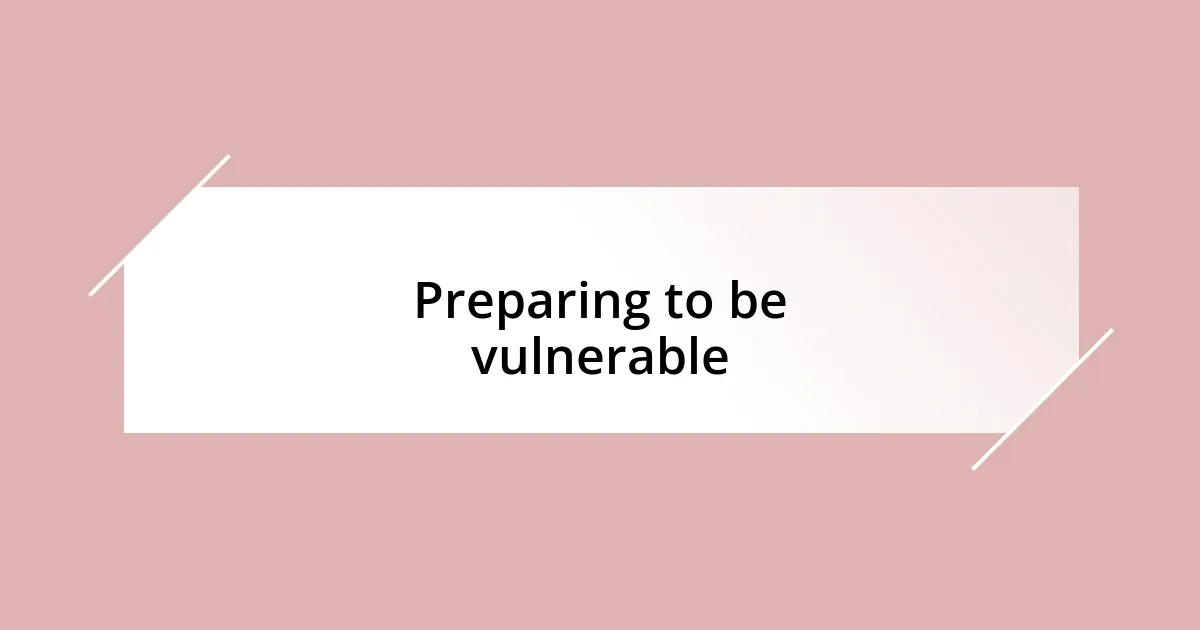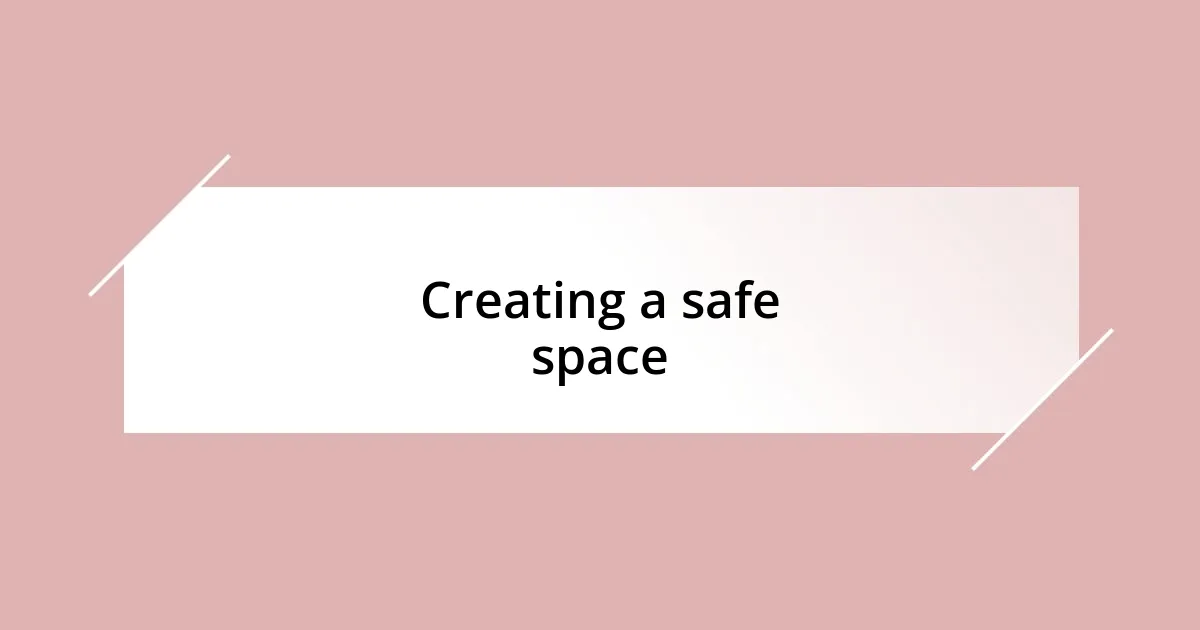Key takeaways:
- Embracing vulnerability in therapy facilitates deeper connections, authenticity, and emotional resilience, altering one’s approach to healing.
- Creating a safe environment and preparing emotionally, such as writing down feelings, enhances the ability to share vulnerable thoughts during sessions.
- Techniques like using “I” statements, storytelling, and allowing silence can effectively foster a deeper exploration of emotions in therapy.
- Overcoming the fear of vulnerability leads to personal strength and authenticity, paving the way for transformative connections with others.

Understanding vulnerability in therapy
Vulnerability in therapy is more than just sharing our deepest fears; it’s an invitation to explore our true selves without judgment. I remember the first time I shared a painful memory; my heart raced, and I felt exposed, yet there was an undeniable sense of relief. Isn’t it fascinating how this act of openness can reshape our healing journey?
In many ways, embracing vulnerability requires courage. I once held back a particular story, thinking it was too raw to discuss. But once I finally opened up, I was met with understanding and support that I’d never expected. Have you ever held back something important, only to discover that sharing it lightens your burden?
Therapy isn’t just about learning new skills; it’s a space to practice being real with ourselves. When I allowed myself to be vulnerable, I learned to connect with my emotions on a deeper level. It made me wonder—how much growth might we miss out on if we continue to shield ourselves from vulnerability?

Benefits of embracing vulnerability
Embracing vulnerability in therapy brought me unexpected benefits that fundamentally changed my approach to healing. One memorable moment was when I shared my struggle with anxiety. The weight of that secret had been exhausting, but as I gradually exposed those feelings, I felt a wave of relief wash over me. It was as if a heavy fog had lifted, allowing clarity and understanding to seep in.
Consider the following benefits of embracing vulnerability:
- Deepened Connection: Sharing personal stories fosters a stronger bond with the therapist, creating a safe and open environment for growth.
- Enhanced Authenticity: I noticed that being vulnerable encouraged me to show up as my true self, which led to a more genuine therapeutic experience.
- Increased Emotional Resilience: Facing fears and discomfort head-on, I found myself better equipped to handle challenges outside of our sessions.
- Empowerment Through Acceptance: Allowing myself to feel and express difficult emotions shifted my perspective; instead of seeing vulnerability as a weakness, I began to view it as a source of strength.
- Openness to New Perspectives: I discovered that when I shared my struggles, I became more receptive to diverse viewpoints, enriching my understanding of myself and my experiences.

Preparing to be vulnerable
Preparing to be vulnerable can seem daunting, but it’s an essential first step towards meaningful progress in therapy. I remember when I decided to write down my worries before a session. It felt like I was laying my fears bare on paper, and that process helped me prepare emotionally for the conversation ahead. Have you ever taken time to reflect before sharing something vulnerable? It’s a game-changer.
As I embraced this preparation, I discovered that creating a comfortable environment at home helped ease my anxiety. Lighting a candle and playing soft music transformed my space into a retreat for introspection. I often found myself asking, “What do I need to express today?” This kind of intentional setup empowered me and allowed me to step into vulnerability with more confidence.
Ultimately, recognizing that vulnerability isn’t about perfection but about honesty changed my outlook. One of my most impactful sessions involved sharing a seemingly trivial fear about public speaking. This opened the door to deep conversations about self-worth and acceptance. I learned to trust that my experiences, no matter how small, have significant value in the therapeutic journey.
| Preparation Techniques | Emotional Impact |
|---|---|
| Writing down thoughts | Clarifies and organizes emotions |
| Creating a safe environment | Reduces anxiety and increases comfort |
| Mindfulness and reflection | Enhances self-awareness |

Techniques for sharing vulnerability
One effective technique for sharing vulnerability is to use “I” statements when expressing feelings. For instance, instead of saying, “I feel overwhelmed,” try, “I struggle with feeling overwhelmed at times.” This slight shift not only conveys your experience but also makes it easier to engage in deeper discussions. I’ve found that framing my emotions this way invites more dialogue and understanding from my therapist, making the process feel less isolating.
Another powerful method is storytelling. When I share specific instances from my life, it provides both context and relatability. I remember describing a moment when I broke down during a family gathering; the fears of judgment flooded my mind. By narrating this experience, I not only exposed my vulnerability but also uncovered patterns in my feelings that I hadn’t realized before. It felt like putting together pieces of a puzzle, leading to greater self-awareness.
Lastly, embracing silence can be incredibly powerful during such conversations. I’ve noticed that allowing moments of stillness can give both me and my therapist space to reflect on what’s been shared. In one session, I shared a particularly painful memory, and after expressing it, I took a deep breath and sat quietly. Those few seconds felt heavy, yet they allowed me to feel the weight of my truth. Have you ever experienced that pause after sharing something deep? It really solidifies the connection and invites the feelings to settle.

Creating a safe space
Creating a safe space is something I quickly realized would be the cornerstone of my therapy sessions. I remember the first time I walked into my therapist’s office—I instantly felt at ease because of the warm colors and soft lighting. It made me think: how much does our environment truly affect our emotional state? A well-designed space can lessen our fears and create room for authentic sharing.
Opening up in a judgment-free zone is crucial. I once shared a deeply personal story about my childhood, and my therapist’s attentive nod and reassuring smile told me I was safe to express my feelings without fear. It confirmed what I often remind myself: vulnerability thrives in acceptance. Have you ever experienced a moment where you felt completely free to express yourself? Those magical moments can foster incredible growth.
I’ve learned that actively inviting honesty into the conversation can also enhance that safety. During one session, I voiced my worries about not being “good enough” to deserve help. To my surprise, my therapist acknowledged my feelings without fixing them or rushing to provide solutions. That acknowledgment transformed the atmosphere; it felt like a bubble of safety where I could explore my feelings without pressure, allowing for a deeper dive into vulnerability. This kind of mutual understanding is truly vital in building a safe space.

Overcoming fear of vulnerability
Overcoming the fear of vulnerability is a journey I found incredibly enlightening. I vividly recall the first time I hesitated to share something deeply personal. My heart raced, and I thought, “What if they judge me?” But I realized that those judgments were more about my own internal fears than reality. The moment I took a breath and opened up, I felt an unexpected relief wash over me. Has fear ever held you back from expressing what’s truly on your mind?
It’s fascinating how confronting vulnerability can turn fear into strength. I remember a session where I was tasked with reflecting on my past relationships. Initially, I felt paralyzed by the thought of exposing my insecurities. But as I slowly unpacked my experiences, I discovered an overwhelming sense of connection to my core self. By allowing myself that space to feel uneasy, I found courage in confronting those hidden emotions. There’s a unique power in understanding that vulnerability doesn’t weaken us; it enriches our experiences.
As I learned to face my fear, a breakthrough realization struck me: vulnerability is not just about exposure; it’s about embracing true authenticity. I had a moment during therapy where I shared a fear of being seen as “too much.” To my surprise, my therapist didn’t flinch or shy away—instead, they reflected back the strength in my emotions. It hit me then: when I dare to be vulnerable, I give others permission to do the same. This reciprocity transforms fear into a shared experience, fostering deeper connections. Have you ever considered how vulnerability might open doors to understanding in your relationships?

Reflecting on vulnerability experiences
Reflecting on my vulnerability experiences has often felt like peeling back layers of an onion. I remember one session where I was prompted to reflect on a failure I had been avoiding. As I described the event, I felt my chest tighten, but then a wave of clarity washed over me. Why do we hold onto our failures so tightly? Through that reflection, I realized that each misstep carried a lesson, and sharing those lessons openly created intimacy and trust with my therapist.
There was a moment during my journey when I shared how my fear of disappointing others had stifled my own desires. I can still hear my voice trembling as I expressed this fear, the weight of secrecy lifting with each word. It struck me that vulnerability can sometimes feel like a leap into the unknown, and yet, every time I took that leap, I found a newfound strength waiting on the other side. Have you ever found that confronting an uncomfortable truth not only lightened your burden but also made you feel more grounded?
Looking back, I see how each time I embraced vulnerability, I carved a path toward deeper self-understanding. I often left sessions feeling invigorated, akin to emerging from a forest after a rainstorm—everything felt clearer and more vibrant. There’s something so powerful about confronting our truths. When you dare to be vulnerable, you invite a transformation not just within yourself but also in the connections you build with others. I wonder how many people refrain from this journey because they fear what lies beneath the surface.














